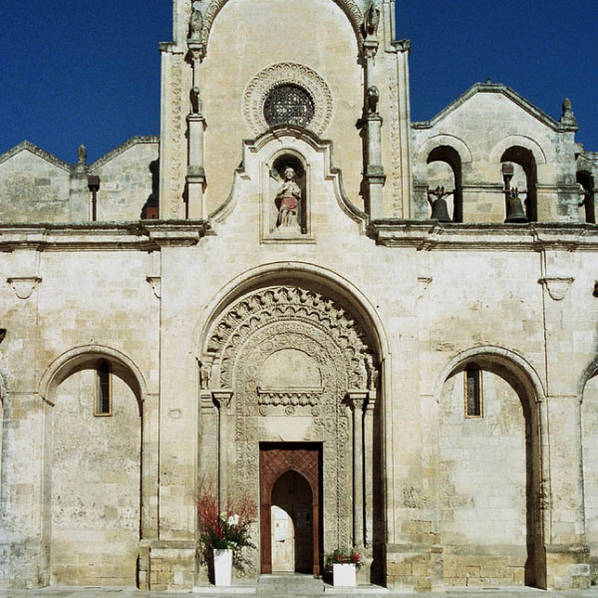
Outside
The church of San Giovanni Battista was considered the architectural jewel of Matera during the Middle Ages for its refined architectural composition and fine decoration. Currently we cannot fully perceive this whole because the current aspect it presents us is actually the side facade, as the main one was incorporated in 1610 in the construction of the Hospital (next building).
Formerly known as Santa Maria La Nova it was intended for the nine penitent nuns of Accon brought to Matera by Bishop Andrea before 1193 from Palestine, but it was also called Santa Maria ai Foggiali from the Latin name “Fovea” that is, hole, which was rich in the area to preserve foodstuffs such as cereals and legumes.
It was the first sacred building to rise outside the walls and was completed in 1233, but during the Otranto war (1480) it was abandoned as the place was considered dangerous for the nuns, being isolated and outside the defensive walls of the city . It was reopened for worship only in 1695 by Monsignor del Ryos with its current name, but following the long state of abandonment, drastic structural changes were necessary. Despite the overlapping for reasons of consolidation of an arched wall leaning against the facade, we can grasp the extreme elegance of the structure in some details: the portal, the work of master stonemasons Michele Del Giudice and Marco Di Lauria in the center, finely carved with plant volutes and motifs of sculpted heads that recall that of the cathedral (door of the lions), and, at the top, in the center of the tympanum, the small rose window surrounded by hanging columns and pillars, decorated with unique zoomorphic sculptures.
Under the rose window, a polychrome stone statue of St. John the Baptist holding the Gospel in his hand on which a lamb rests (18th century). The exterior of the apse (side on the right looking at the portal) is the part that has undergone fewer structural changes; at the top of the tympanum (upper part) a carved angel watches over the church, while lower down, in the center, the large round arch is flanked by shelves surmounted by elephants. Still further down, a single-window aedicule window illuminates the interior through the stained glass window and is flanked by columns with characteristic zoomorphic figures; the work around the opening recalls that of the Romanesque portal.
Inside
Upon entering, we can perceive the original medieval atmosphere thanks to the abbot Marcello Morelli who, in 1926, removed the eighteenth-century stuccos from the sober limestone in which the interiors are made, bringing the environment back to its initial simplicity and elegance: the plant is Latin cross and the three naves are marked by four-lobed pillars with semi-attached columns and each have a splendid figured capital with anthropomorphic, zoomorphic and plant motifs different from the others with a highly symbolic and representative value of the spirit and medieval religiosity and support large transverse arches that they form large cross vaults.
The first chapel of the left nave houses the 16th century fresco “Madonna delle Nove”. On the cornice there is a sculptural group from the workshop of Altobello Persio: the Annunciation and God the Father who holds the sphere symbol of all humanity. The next chapel is dedicated to the medical saints Cosimo and Damiano, Christian martyrs represented here in two beautiful wooden statues with the characteristic rich red and green cloaks, which are carried in procession by the devotees on the last Sunday of September. In the same chapel, on the altar, a canvas from the 18th century by Vito Antonio Conversi depicting the Virgin in glory with the saints S. Antonio Abate, S. Domenico, S. Eligio, S. Cosma, S. Biagio and S. Vincenzo. Continuing along the same nave, seventeenth-century polychrome wood sculpture, very expressive and intense, “Pietà” of 1888 by the Matera sculptor Pasquale Calabrese. At the beginning of this nave, there is an interesting detail: a graffiti at the base of a column placed laterally on the large pillar, next to the confessional: “DIE 29 DEC … INTERFECTUS COMES.” It reminds us of the killing of Count Tramontano in 1514 (SEE PANORAMIC POINT NEAR CATHEDRAL). The sculpture of the baptismal font is recent, made by Ercole Raduzzi in 1929; in the same nave, in a niche, there is the sixteenth-century tuff statue of S. Giovanni, from the nursery school, once placed on the high altar, which is almost identical to that placed on the facade in the niche under the small rose window, which bears in his hand the gospel on which a lamb is crouched, symbol par excellence of St. John the Baptist.